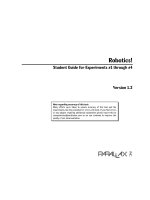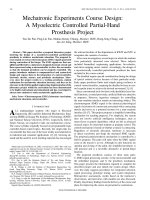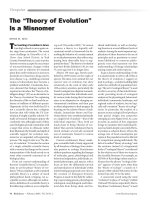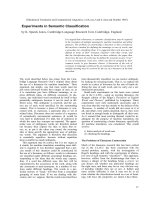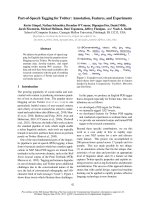Lamboo experiments
Bạn đang xem bản rút gọn của tài liệu. Xem và tải ngay bản đầy đủ của tài liệu tại đây (443.8 KB, 5 trang )
World Academy of Science, Engineering and Technology 34 2007
Experimental Studies on the Mechanical
Property of Laminated Bamboo in Thailand
S. Talabgaew, and V. Laemlaksakul
experimental, dedicated to estimating strength and stiffness
properties [3, 4]. In these studies, a new ecomaterial, laminate
bamboo was developed. Various mechanical properties,
including tensile, compressive, flexural strength and shear
strength, were measured and compared with those of laminate
bamboo. Furthermore, the hygroscopic properties of this new
material were also evaluated. Finally, the recycling ability of
this material was studied and discussed. All four species hold
great potential for value-added utilization and can provide a
less expensive and high quality alternative to wood for
furniture industrial applications.
Abstract—A new generation product made from bamboo strips,
known as laminated bamboo, has gained importance. The objective
of this research was to experiment the effect of three factors on the
mechanical property of laminated bamboo. The interested factors for
experimental design were (A) four bamboo species, namely Bambusa
blumeana Schultes (Pai See Suk), Dendrocalamus asper Backer (Pai
Tong), Dendrocalamus hamiltonii Nees (Pai Hok) and
Dendrocalamus sericeus Munro (Pai Sang Mon), (B) two types of
glue adhesive, polyvinyl acetate emulsion (PVAC) fortified with
urea-formaldehyde (UF) and urea-formaldehyde (UF) to make
parallel-oriented bamboo strips laminates and (C) glue weight per
strip area, 150 g/m2 and 190 g/m2. Experimental results showed that
Dendrocalamus asper Backer (Pai Tong) and Dendrocalamus
sericeus Munro (Pai Sang Mon) were best used for manufacturing
due to their highest MOR and MOE. The amount of glue weight 150
g/m2 yielded higher MOR and MOE than the amount of glue weight
190 g/m2. At the conclusion, the laminated bamboo manufacturers
can benefit from this research in order to select right materials
according to strength, cost and accessibility.
II. METHODOLOGY
A. Bamboo and Preparation of Material
The bamboo used in the present work were Bambusa
blumeana Schultes (Pai See Suk), Dendrocalamus asper
Backer (Pai Tong), Dendrocalamus hamiltonii Nees (Pai Hok)
and Dendrocalamus sericeus Munro (Pai Sang Mon)
purchased in the Thailand. Bamboos were cut at least one
meter above the ground to remove hard solid stem. The first
few meters at the bottom of the culms were in general stronger
than that at the top. A selected bamboo culms has approximate
120 mm outer diameter and wall thickness 12 mm. Round
bamboos were spited with parallel grain into strips. Bamboo
strips were dried to low moisture content (12%) as part of the
manufacturing process. The detailed were reported previously
[5].
Two types of adhesives, namely (1) polyvinyl acetate
emulsion (PVAC) fortified with urea-formaldehyde (UF), (2)
Urea-Formaldehyde (UF) adhesives were used in the
experiments. The adhesives were applied to one side of
bamboo strip at 150 g/m2 and 190 g/m2. A hydraulic hot press,
generally used for making plywood, provided temperature at
150 C, pressure perpendicular to glue-lines at 50 kg/cm2 and
pressing time at 20 minutes. The surfaces of all laminate
bamboo were roughened by sandpaper.
Keywords—Laminated Bamboo, Mechanical Property, 3-Way
ANOVA.
I. INTRODUCTION
I
N the past period of composite-materials development, only
mechanical and functional performances were taken into
account in the design and processing. In recent years, the
realization of environmental crisis has dramatically changed
the priorities for research and development of composite
materials. Now it is time for us to think not only of better
performance, but also of how materials and related
technologies can become less hazardous to the environment.
Among biological structures, the natural fibers are very
interesting for engineering applications due to their low cost
and convenient availability. They grow abundantly in tropical
and subtropical regions of the world, and they can be usefully
employed as construction materials [1, 2].
Most work in the literature that characterizes bamboo is
Manuscript received September 29, 2007. This research was a part of a
research project titled “Development of Laminated Bamboo Furniture
Manufacturing” supported by the National Budget of Thailand (the fiscal year
2007) under code: 5003110525032.
Sompoap Talabgaew is an Assistant Professor in the Teacher Training in
Mechanical Engineering Department, King Mongkut’s Institute of
Technology North Bangkok, Bangkok, Thailand (e-mail: ).
Vanchai Laemlaksakul is an Associate Professor in the Industrial
Engineering Technology Department, King Mongkut’s Institute of
Technology North Bangkok, Bangkok, Thailand (phone: 662-913-2500; fax:
662-587-4356; e-mail: ).
B. 3-Way ANOVA
This research focused on the experimental study of three
factors as (1) four bamboos species, (2) two glue-weights, and
(3) two glue-types as shown in Table I. The laminated
bamboos were experimented under these factors to find
mechanical properties; Modulus of Resistance (MOR) and
Modulus of Elastic (MOE). Each experiment ran 5 replicates
327
World Academy of Science, Engineering and Technology 34 2007
so that the total experiments for MOR and MOE testing were
80 runs as shown in Table II respectively. An analysis for this
research used three-way analysis of variance (3-Way
ANOVA), instead two-level factorial design [6, 7] because
factor A (bamboo species) has 4 levels as explained in Table I.
3-Way Analysis of variance (3-Way ANOVA) is similar to
Multiple-Regression in that it is used to investigate and model
the relationship between a response variable and three
independent variables. However, 3-way analysis of variance
differs from regression in two ways: the independent variables
are qualitative (categorical) or quantitative variable, and no
assumption is made about the nature of the relationship that is,
the model does not include coefficients for variables. The
hypothesis of three factors is for testing the equality of more
than two population means, versus them not all being equal
[8].
Factors
(A) = Bamboo
(B) = Glue Weight
(C) = Glue Adhesive
TABLE II
THE DESIGN OF EXPERIMENT FOR MOR AND MOE
Glue Weight
Glue Types (C)
Bamboo
(g/m2)
PVAC + UF
UF
(B)
(A)
H 0 : μ1 = μ 2 = ... = μ k
H 1 : μ i ≠ μ j for at least one pair (i, j)
TABLE I
FACTORS AND TREATMENTS
Treatment
1 Dendrocalamus asper Backer (Pai Tong)
2 Bambusa blumeana Schultes (Pai See Suk)
3 Dendrocalamus sericeus Munro
(Pai Sang Mon)
4 Dendrocalamus hamiltonii Nees (Pai Hok)
1 150 g/m2
2 190 g/m2.
1 Polyvinyl acetate + Urea formaldehyde
(PVAC + UF)
2 Urea-formaldehyde(UF)
Pai Tong
(1)
C. Testing of Laminated Bamboo
Static bending was considered as one of the important
mechanical properties of wood products [9] because it
represents the durability and strength especially the new
generation furniture design made by laminated bamboo. Static
bending properties were tested according to British Standards
for Testing Small Clear Specimens of Timber (BS373:1957)
using Universal Testing Machine, Testometric FS-300 kN
MICO 500.
The dimensions of the central loading specimen are 20 mm
width (w) x 20 mm depth (d) x 300 mm length (l) and the
distance between the points of support of the test piece (L) is
280 mm. Standard load heads were controlled at the constant
speed of 0.26 in/min as shown in Fig. 1.
Pai See Suk
Pai Sang Mon
Pai Hok
150
5 Replicates
5 Replicates
190
5 Replicates
5 Replicates
150
5 Replicates
5 Replicates
190
5 Replicates
5 Replicates
150
5 Replicates
5 Replicates
190
5 Replicates
5 Replicates
150
5 Replicates
5 Replicates
190
5 Replicates
5 Replicates
III. RESULTS
A. MOR Results
The 3-way ANOVA was used to analyzed the experiment
and the significant level was set at 0.05 (α = 0.05). Results
from MINITAB are shown in Table III.
From Table III, the main factors that strongly affect MOR
are bamboo (A) and glue weight (B) at significant level of
0.05 because their p-value is less than 0.05. Glue Adhesive
(C) is not significant to MOR because its p-value is larger
than p-value [8]. All interactions have no effect on MOR
because their p-value is more than 0.05 so they can be ignored
for this research.
Fig. 1 Static Bending Testing
328
World Academy of Science, Engineering and Technology 34 2007
TABLE III
MOR RESULTS
General Linear Model: MOR versus Bamboo (A), Glue Weight (B),
Glue Adhesive (C)
TABLE IV
MOE RESULTS
General Linear Model: MOE versus Bamboo (A), Glue Weight (B),
Glue Type (C)
Factor
Bamboo (A)
Glue Weight (B)
Glue Adhesive (C)
Factor
Type
Levels
Bamboo (A)
fixed
4
Glue Weight (B) fixed
2
Glue Type (C)
fixed
2
Values
1, 2, 3, 4
1, 2
1, 2
Analysis of Variance for MOE
Source
DF Seq SS
Bamboo (A)*
3 104771687
Glue Weight (B)* 1
18760814
Glue Type (C)
1
5786190
(A)*(B)*
3
18861259
(A)*(C)*
3
21968288
(B)*(C)
1
4905947
Error
67 152198153
79 327252338
TOTAL
Adj MS
F
34923896 15.37
18760814 8.26
5786190 2.55
6287086 2.77
7322763 3.22
4905947 2.16
2271614
Type Levels Values
fixed
4
1, 2, 3, 4
fixed
2
1, 2
fixed
2
1, 2
Analysis of Variance for MOR
Source
DF SS
Bamboo (A)
3 23085.3
Glue Weight (B)
1 3586.5
Glue Adhesive (C) 1 2804.1
(A)*(B)
3 5620.3
(A)*(C)
3 377.7
(B)*(C)
1 943.2
Error
67 52299.5
Total
79 88716.6
Adj MS
7695.1
3586.5
2804.1
1873.4
125.9
943.2
780.6
F
9.86
4.59
3.59
2.40
0.16
1.21
P
0.000*
0.036*
0.062
0.076
0.922
0.276
Main Effects Plot (fitted means) for MOR
Bamboo (A)
P
0.000*
0.005*
0.115
0.048*
0.028*
0.146
Main Effects Plot (fitted means) for MOE
Glue Weight (B)
Bamboo (A)
16000
190
Glue Weight (B)
15500
Mean of MOE
Mean of MOR
180
170
160
2
3
4
1
2
1
Fig. 2 Main effects plot for bamboo (A) and glue weight (B)
affecting to MOR
Normal Probability Plot of the Residuals
Residuals Versus the Fitted Values
50
Residual
90
50
10
0
-50
1
0.1
-100
-50
0
Residual
50
100
140
Histogram of the Residuals
160
180
Fitted Value
200
Residuals Versus the Order of the Data
20
50
Residual
15
10
5
3
4
1
2
Normally, the MOR of laminated bamboo should be as
much as possible. From Fig. 2, Bamboo factor (A), Pai Tong
(labeled as 1) has the highest MOR and Pai Sang Mon
(labeled as 3) has the second highest MOR but, on the other
hand, Pai Hok (labeled as 4) has the lowest MOR. It can be
said that Pai Tong and Pai Sang Mon can be substituted each
other because there are not much different MOR. Glue weight
(B), at the amount 150 g/m2 (labeled as 1), yields more MOR
than at the amount 190 g/m2 (labeled as 2).
Fig. 3 shows the residual plot of MOR and all residual plots
are normally distributed and randomly. This can be concluded
that the experimental design for MOR was fairly acceptable.
99.9
99
2
Fig. 4 Main effects plot for bamboo (A) and glue weight (B)
affecting to MOE
Residual Plots for MOR
Percent
14000
13000
1
Frequency
14500
13500
150
0
15000
0
-50
-80
-60
-40
-20
0
Residual
20
40
60
1 5 10 15 20 25 30 35 40 45 50 55 60 65 70 75 80
B. MOE Results
Results of MOE analysis were as same as MOR analysis.
The results from MINITAB are shown in Table IV.
The main factors that strongly affect MOE are still bamboo
species (A) and glue weight (B) at significant level of 0.05
because their p-value is less than 0.05. Glue Again, glue
adhesive (C) is not significant to MOE because its p-value is
Observation Order
Fig. 3 Residual plots for MOR
329
World Academy of Science, Engineering and Technology 34 2007
Sang Mon (dotted line) and Pai Tong (solid line). At the same
way, a bottom left plot, the number 1, 2, 3, and 4 on X-axis
represents each bamboo species. Pai Sang Mon (labeled as 3)
and Pai Tong (labeled as 1) yield higher MOE when they
interact with glue weight at the amount 150 g/m2 (solid line)
than at the amount 190 g/m2 (doted line). These interpretations
follow the MINITAB results in Table IV.
Fig. 6 shows the residual plot of MOE and all residual plots
are normally distributed and randomly. This can be concluded
that the experimental design for MOR was fairly acceptable.
larger than p-value [8]. However, there are slightly different
from MOR results because MOE results yield interaction
effects that are interactions AB and AC because their p-value
is less than 0.05 as shown in Table IV. Although interaction
AC (Bamboo*Glue Adhesive) is significant, Glue Adhesive
(C) is not significant so that its interaction can be ignored as
well. This research only considered AB interaction. Similarly,
MOE of laminated bamboo should be as much as possible as
well. From Fig. 4, bamboo factor (A), Pai Sang Mon (labeled
as 3) has the highest MOE and Pai Tong (labeled as 1) has the
second highest MOE that are totally opposite from MOR
results but, as same as MOR results, Pai Hok (labeled as 4) is
still the lowest MOE. It can be concluded that Pai Tong and
Pai Sang Mon can be substituted each other because there are
not much different MOE. Glue weight (B), at the amount 150
g/m2 (labeled as 1) yields more MOE than at the amount 190
g/m2 (labeled as 2).
IV. CONCLUSION
This research was aimed to find the appropriate factors
affecting mechanical properties of laminated bamboo (MOR
and MOE) by using experimental design. Three-way analysis
of variance (3-way ANOVA) is of interest because each factor
has different level. Bamboo species (A), Glue weight and
Glue type have 4, 2 and 2 levels respectively.
The amount of experiments was 80 runs. The MOR results
show that the main factors affecting to MOR of laminated
bamboo are only bamboo species (A) and glue weight (B) but
glue type (C) is not significantly influenced. There are no any
interaction effects affecting to MOR. For bamboo species (A),
Pai Tong yields the highest MOR and Pai Sang Mon is the
second highest MOR For glue weight (B), the amount of glue
weight 150 g/m2 gives higher MOR than the amount of glue
weight 190 g/m2.
The MOE results are most likely as same as MOR results.
Bamboo species (A) and glue weight (B) are still significant to
mechanical properties of laminated bamboo. Unlike MOR
results, Pai Sang Mon yields the higher MOE than Pai Tong.
The amount of glue weight 150 g/m2 gives higher MOE than
the amount of glue weight 190 g/m2. Furthermore, there is AB
interaction effect (bamboo species*glue weight).
The benefits from this research can help the large-scale
laminated bamboo production selecting right materials
according to strength and cost as follows;
1) Pai Tong or Pai Sang Mon is the best for laminated
furniture manufacturing due to its mechanical properties.
2) The MOR and MOE of using glue weight 150 g/m2 and
190 g/m2 are not different resulting to cost-effective
production.
3) Glue types (PVAC + UF and UF) are not influenced to
mechanical and physical properties of laminated bamboo so
the manufacturers can use either one of them depending on
accessibility, cost, environmental effect, safety etc.
Interaction Plot (fitted means) for MOE
1
2
16000
15000
14000
Bamboo (A)
Bamboo (A )
1
2
3
4
13000
12000
16000
15000
14000
Glue Weight (B)
Glue
Weight
(B)
1
2
13000
12000
1
2
3
4
Fig. 5 Interaction plots for bamboo (A) and glue weight (B)
affecting to MOE
Residual Plots for MOE
Normal Probability Plot of the Residuals
Residuals Versus the Fitted Values
99.9
4000
90
Residual
Percent
99
50
10
2000
0
-2000
1
0.1
-5000
-2500
0
Residual
2500
-4000
5000
Histogram of the Residuals
16000
4000
15
Residual
Frequency
13000 14000 15000
Fitted Value
Residuals Versus the Order of the Data
20
10
2000
0
-2000
5
0
12000
-2000
0
2000
Residual
4000
-4000
ACKNOWLEDGMENT
1 5 10 15 20 25 30 35 40 45 50 55 60 65 70 75 80
Observation Order
Authors thank the College of Industrial Technology, King
Mongkut’s Institute of Technology North Bangkok, for
providing the experimental setup to perform this research.
Fig. 6 Residual plots for MOE
Fig. 5 shows the interaction effect AB (bamboo*glue
weight). Considering the top right plot, at glue weight 150
g/m2 level (labeled as1) seems to gain higher MOE than at
glue weight 190 g/m2 (labeled as 2) when it interacts with Pai
330
World Academy of Science, Engineering and Technology 34 2007
[6]
REFERENCES
[1]
[2]
[3]
[4]
[5]
J. J. A. Janssen, Building with bamboo. 2nd ed. London: Intermediate
Technology Publications, 1995.
D. L. Jayanetti, and P. R. Follett, Bamboo in construction: An
introduction. Buckinghamshire: TRADA Technology, 1998.
T. Y. Lo, H. Z. Cui, and H. C. Leung, “The effect of fiber density on
strength capacity of bamboo,” Material Letters, vol. 58, pp. 2595-2598,
2004.
S. H. Li, S. Y. Fu, Q. Y. Zeng, Y. L. Xiao, and B. L. Zhou, “Biomimicry
of bamboo bast fibre with engineering composite material,” Material
Science and Engineering, C 3, 125-130, 1995.
V. Laemlaksakul, and S. Kaewkuekool, “Laminated bamboo materials
for furniture – A systematic approach to innovative product design,”
WSEAS Transactions on Engineering Education, vol. 3, pp. 424-430,
May 2006.
[7]
[8]
[9]
331
S. A. Abdul-Wahab and J. Abdo, “Optimization of multistage flash
desalination process by using a two-level factorial design,” Applied
Thermal Engineering, vol. 27, pp. 413-421, February 2007.
T. S. Chan, R. Bhagwat, and S. Wadhwa, “Flexibility performance:
Taguchi's method study of physical system and operating control
parameters of FMS,” Robotics and Computer-Integrated Manufacturing,
vol. 23, pp. 25-37, February 2007.
D. C. Montgomery, Design and Analysis of Experiments. 5th ed., Wiley
& Sons, 2001.
C. Eamon et al, “Reliability-based criteria for load and resistance factor
design code for wood bridges,” Transportation Research Record,
no.1696, vol. 1, pp.316-322, 2000.

